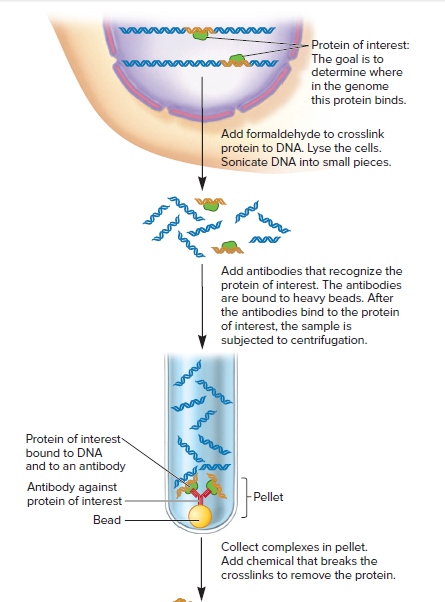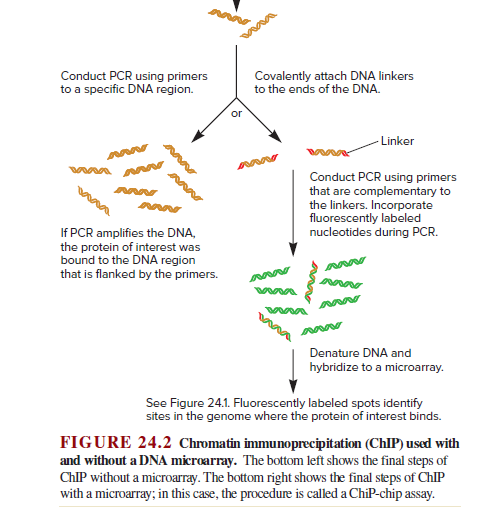- Protein of interest: The goal is to determine where in the genome this protein binds. Add formaldehyde to crosslink protein to DNA. Lyse the cells. Sonicate DNA into small pieces. Add antibodies that recognize the protein of interest. The antibodies are bound to heavy beads. After the antibodies bind to the protein of interest, the sample is subjected to centrifugation. Protein of interest bound to DNA and to an antibody Antibody against protein of interest Pellet Bead Collect complexes in pellet. Add chemical that breaks the crosslinks to remove the protein. Conduct PCR using primers to a specific DNA region. Covalently attach DNA linkers to the ends of the DNA. or - Linker Conduct PCR using primers that are complementary to the linkers. Incorporate fluorescently labeled nucleotides during PCR. If PCR amplifies the DNA, the protein of interest was bound to the DNA region that is flanked by the primers. Denature DNA and hybridize to a microarray. See Figure 24.1. Fluorescently labeled spots identify sites in the genome where the protein of interest binds. FIGURE 24.2 Chromatin immunoprecipitation (ChIP) used with and without a DNA microarray. The bottom left shows the final steps of CHIP without a microarray. The bottom right shows the final steps of CHIP with a microarray; in this case, the procedure is called a ChiP-chip assay.
Molecular Techniques
Molecular techniques are methods employed in molecular biology, genetics, biochemistry, and biophysics to manipulate and analyze nucleic acids (deoxyribonucleic acid (DNA) and ribonucleic acid (RNA)), protein, and lipids. Techniques in molecular biology are employed to investigate the molecular basis for biological activity. These techniques are used to analyze cellular properties, structures, and chemical reactions, with a focus on how certain molecules regulate cellular reactions and growth.
DNA Fingerprinting and Gel Electrophoresis
The genetic makeup of living organisms is shown by a technique known as DNA fingerprinting. The difference is the satellite region of DNA is shown by this process. Alex Jeffreys has invented the process of DNA fingerprinting in 1985. Any biological samples such as blood, hair, saliva, semen can be used for DNA fingerprinting. DNA fingerprinting is also known as DNA profiling or molecular fingerprinting.
Molecular Markers
A known DNA sequence or gene sequence is present on a chromosome, and it is associated with a specific trait or character. It is mainly used as a genetic marker of the molecular marker. The first genetic map was done in a fruit fly, using genes as the first marker. In two categories, molecular markers are classified, classical marker and a DNA marker. A molecular marker is also known as a genetic marker.
DNA Sequencing
The most important feature of DNA (deoxyribonucleic acid) molecules are nucleotide sequences and the identification of genes and their activities. This the reason why scientists have been working to determine the sequences of pieces of DNA covered under the genomic field. The primary objective of the Human Genome Project was to determine the nucleotide sequence of the entire human nuclear genome. DNA sequencing selectively eliminates the introns leading to only exome sequencing that allows proteins coding.
Why is an antibody used in this experiment?


Trending now
This is a popular solution!
Step by step
Solved in 2 steps









